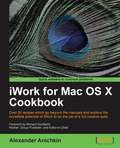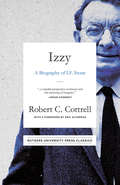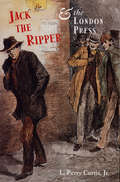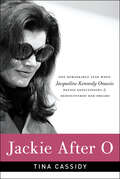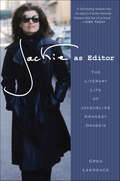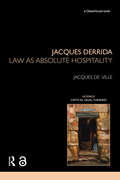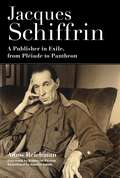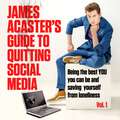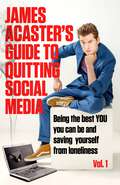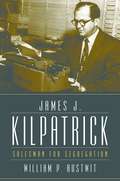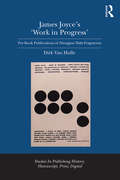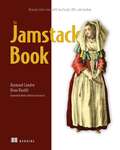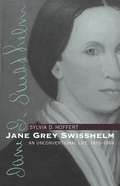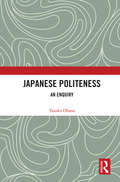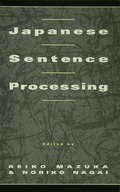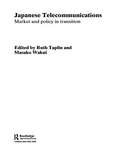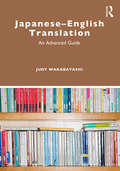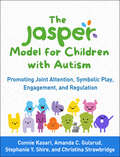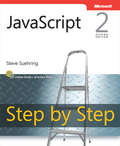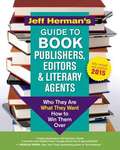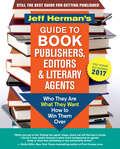- Table View
- List View
iWork for Mac OSX Cookbook
by Alexander AnichkinThis book is packed with illustrations and tips to master all the components of the iWork suite and the cookbook problem-solution approach eases the learning curve. This book will show both the new and the confident iWork user how this inexpensive software has all the potential of full creative suites to produce professional quality documents, from unique logos to glossy magazines.
Izzy: A Biography of I. F. Stone
by Robert C. CottrellThis is the classic story of the life and times of I. F. “Izzy” Stone. Robert Cottrell weaves together material from interviews, letters, archival materials, and government documents, and Stone’s own writings to tell the tale of one of the most significant journalists, intellectuals, and political mavericks of the twentieth century. The story of I. F. Stone is the tale of the American left over the course of his lifetime, of liberal and radical ideals which carried such weight throughout the twentieth century, and of journalism of the politically committed variety. Now available in a handsome new Rutgers University Press Classic edition, it is an examination of the life and career of a gregarious yet frequently grumpy loner who became his nation’s foremost radical commentator provides a window through which to examine American radicalism, left-wing journalism, and the evolution of key strands of Western intellectual thought in the twentieth century.
Jack the Ripper & the London Press
by L. Perry Curtis Jr.&“Breaks new ground in its examination of the role of newspaper reporting during the police hunt for the first notorious serial killer.&”—Reviews in History Press coverage of the 1888 mutilation murders attributed to Jack the Ripper was of necessity filled with gaps and silences, for the killer remained unknown and Victorian journalists had little experience reporting serial murders and sex crimes. This engrossing book examines how fourteen London newspapers—dailies and weeklies, highbrow and lowbrow—presented the Ripper news, in the process revealing much about the social, political, and sexual anxieties of late Victorian Britain and the role of journalists in reinforcing social norms. L. Perry Curtis surveys the mass newspaper culture of the era, delving into the nature of sensationalism and the conventions of domestic murder news. Analyzing the fourteen newspapers—two of which emanated from the East End, where the murders took place—he shows how journalists played on the fears of readers about law and order by dwelling on lethal violence rather than sex, offering gruesome details about knife injuries but often withholding some of the more intimate details of the pelvic mutilations. He also considers how the Ripper news affected public perceptions of social conditions in Whitechapel. &“The apparently motiveless violence of the Whitechapel killings denied journalists a structure, and it is the resulting creativity in news reporting that L Perry Curtis Jr describes. His impressive book makes a genuine contribution to 19th-century history in a way that books addressing the banal question of the identity of the Ripper do not.&”—The Guardian
Jackie After O: One Remarkable Year When Jacqueline Kennedy Onassis Defied Expectations & Rediscovered Her Dreams
by Tina CassidyFormer Boston Globe reporter Tina Cassidy delivers a remarkable account of one year in the life of Jacqueline Kennedy Onassis, America’s favorite first lady and an international icon. 1975 was a year of monumental changes for Jackie: it was the year she lost her second husband, shipping magnate Aristotle Onassis, saved one of New York City’s cultural landmarks at Grand Central Station, and found her true calling—not as a powerful man’s wife or the mother of future leaders, but as a woman of the workforce with a keen mind and a dedication to excellence. Readers of Christopher Andersen’s Jackie After Jack and Pamela Clarke Keogh’s Jackie Style will find no better look at the intimate world of America’s Queen of Camelot than Tina Cassidy’s Jackie After O.
Jackie as Editor: The Literary Life of Jacqueline Kennedy Onassis
by Greg LawrenceAn absorbing chronicle of a much overlooked chapter in Jacqueline Kennedy Onassis's life—her nineteen-year editorial career History remembers Jacqueline Kennedy Onassis as the consummate first lady, the nation's tragic widow, the millionaire's wife, and, of course, the quintessential embodiment of elegance. Her biographers, however, skip over an equally important stage in her life: her nearly twenty year long career as a book editor. Jackie as Editor is the first book to focus exclusively on this remarkable woman's editorial career. At the age of forty-six, one of the most famous women in the world went to work for the first time in twenty-two years. Greg Lawrence, who had three of his books edited by Jackie, draws from interviews with more than 125 of her former collaborators and acquaintances in the publishing world to examine one of the twentieth century's most enduring subjects of fascination through a new angle: her previously untouted skill in the career she chose. Over the last third of her life, Jackie would master a new industry, weather a very public professional scandal, and shepherd more than a hundred books through the increasingly corporate halls of Viking and Doubleday, publishing authors as diverse as Diana Vreeland, Louis Auchincloss, George Plimpton, Bill Moyers, Dorothy West, Naguib Mahfouz, and even Michael Jackson. Jackie as Editor gives intimate new insights into the life of a complex and enigmatic woman who found fulfillment through her creative career during book publishing's legendary Golden Age, and, away from the public eye, quietly defined life on her own terms.
Jacques Derrida: Law as Absolute Hospitality (Nomikoi: Critical Legal Thinkers)
by Jacques de VilleJacques Derrida: Law as Absolute Hospitality presents a comprehensive account and understanding of Derrida’s approach to law and justice. Through a detailed reading of Derrida’s texts, Jacques de Ville contends that it is only by way of Derrida's deconstruction of the metaphysics of presence, and specifically in relation to the texts of Husserl, Levinas, Freud and Heidegger - that the reasoning behind his elusive works on law and justice can be grasped. Through detailed readings of texts such as To speculate – on Freud, Adieu, Declarations of Independence, Before the Law, Cogito and the history of madness, Given Time, Force of Law and Specters of Marx, De Ville contends that there is a continuity in Derrida’s thinking, and rejects the idea of an ‘ethical turn’. Derrida is shown to be neither a postmodernist nor a political liberal, but a radical revolutionary. De Ville also controversially contends that justice in Derrida’s thinking must be radically distinguished from Levinas’s reflections on ‘the other’. It is the notion of absolute hospitality - which Derrida derives from Levinas, but radically transforms - that provides the basis of this argument. Justice must on De Ville’s reading be understood in terms of a demand of absolute hospitality which is imposed on both the individual and the collective subject. A much needed account of Derrida's influential approach to law, Jacques Derrida: Law as Absolute Hospitality will be an invaluable resource for those with an interest in legal theory, and for those with an interest in the ethics and politics of deconstruction.
Jacques Schiffrin: A Publisher in Exile, from Pléiade to Pantheon
by Amos ReichmanJacques Schiffrin changed the face of publishing in the twentieth century. As the founder of Les Éditions de la Pléiade in Paris and cofounder of Pantheon Books in New York, he helped define a lasting canon of Western literature while also promoting new authors who shaped transatlantic intellectual life. In this first biography of Schiffrin, Amos Reichman tells the poignant story of a remarkable publisher and his dramatic travails across two continents.Just as he influenced the literary trajectory of the twentieth century, Schiffrin’s life was affected by its tumultuous events. Born in Baku in 1892, he fled after the Bolsheviks came to power, eventually settling in Paris, where he founded the Pléiade, which published elegant and affordable editions of literary classics as well as leading contemporary writers. After Vichy France passed anti-Jewish laws, Schiffrin fled to New York, later establishing Pantheon Books with Kurt Wolff, a German exile. Following Schiffrin’s death in 1950, his son André continued in his father’s footsteps, preserving and continuing a remarkable intellectual and cultural legacy at Pantheon. In addition to recounting Schiffrin’s life and times, Reichman describes his complex friendships with prominent figures including André Gide, Jean-Paul Sartre, Peggy Guggenheim, and Bernard Berenson. From the vantage point of Schiffrin’s extraordinary career, Reichman sheds new light on French and American literary culture, European exiles in the United States, and the transatlantic ties that transformed the world of publishing.
James Acaster's Guide to Quitting Social Media
by James AcasterThis is a self help book like no other. Because you are not helping yourself, James Acaster is helping you.When James quit all forms of social media in 2019 he felt like he'd been born anew, but he was worried he'd suffer withdrawal and get lured back online to compete in a never ending popularity contest with only one possible winner (f*cking Zuckerberg). He knew that in order to stay clean he'd have to replace everything social media used to give him with three-dimensional, real-life activities. And so it was that James found ways to anonymously bully strangers, see photos of everyone's dogs, get invited to as many parties as possible, immediately know about all celebrity deaths, get public figures fired, argue with everybody about everything, and so much more without even owning a phone (he painted over the screen of his old one to stop himself looking at Instagram). His life is amazing and yours could be too if you buy JAMES ACASTER'S GUIDE TO QUITTING SOCIAL MEDIA, BEING THE BEST YOU YOU CAN BE AND SAVING YOURSELF FROM LONELINESS VOL. 1. You will also need to do everything the audiobook tells you to. Including helping us promote the audiobook by tweeting about it.(P) 2022 Headline Publishing Group Ltd
James Acaster's Guide to Quitting Social Media
by James AcasterThis is a self-help book like no other. Because you are not helping yourself, James Acaster is helping you.In 2019, James quit all forms of social media - covering his phone in tar and driving it to a lock-up in Rhyl, before setting up home in a castle he'd built himself called Castle Anti-Net. But when the withdrawal symptoms hit him, he realised in order to stay clean he'd have to replace everything social media gave him with three-dimensional, real-life activities. Employing the help of a mysterious, wealthy benefactor named Clancy Dellahue, and an ever-growing gang of misfits (aka the Tangfastic Crew), James found ways to replace his online friends (he joined the scouts) and spy on his exes (climbing ropes, zip lines, fake moustache) as well as anonymously bullying strangers, seeing photos of everyone's dogs, getting public figures fired, arguing with everybody about everything, and so much more. His life is amazing and yours could be too if you buy JAMES ACASTER'S GUIDE TO QUITTING SOCIAL MEDIA, BEING THE BEST YOU YOU CAN BE AND SAVING YOURSELF FROM LONELINESS VOL. 1.
James Acaster's Guide to Quitting Social Media
by James AcasterThis is a self-help book like no other. Because you are not helping yourself, James Acaster is helping you.In 2019, James quit all forms of social media - covering his phone in tar and driving it to a lock-up in Rhyl, before setting up home in a castle he'd built himself called Castle Anti-Net. But when the withdrawal symptoms hit him, he realised in order to stay clean he'd have to replace everything social media gave him with three-dimensional, real-life activities. Employing the help of a mysterious, wealthy benefactor named Clancy Dellahue, and an ever-growing gang of misfits (aka the Tangfastic Crew), James found ways to replace his online friends (he joined the scouts) and spy on his exes (climbing ropes, zip lines, fake moustache) as well as anonymously bullying strangers, seeing photos of everyone's dogs, getting public figures fired, arguing with everybody about everything, and so much more. His life is amazing and yours could be too if you buy JAMES ACASTER'S GUIDE TO QUITTING SOCIAL MEDIA, BEING THE BEST YOU YOU CAN BE AND SAVING YOURSELF FROM LONELINESS VOL. 1.
James J. Kilpatrick
by William P. HustwitJames J. Kilpatrick was a nationally known television personality, journalist, and columnist whose conservative voice rang out loudly and widely through the twentieth century. As editor of the Richmond News Leader, writer for the National Review, debater in the "Point/Counterpoint" portion of CBS's 60 Minutes, and supporter of conservative political candidates like Barry Goldwater, Kilpatrick had many platforms for his race-based brand of southern conservatism. In James J. Kilpatrick: Salesman for Segregation, William Hustwit delivers a comprehensive study of Kilpatrick's importance to the civil rights era and explores how his protracted resistance to both desegregation and egalitarianism culminated in an enduring form of conservatism that revealed a nation's unease with racial change.Relying on archival sources, including Kilpatrick's personal papers, Hustwit provides an invaluable look at what Gunnar Myrdal called the race problem in the "white mind" at the intersection of the postwar conservative and civil rights movements. Growing out of a painful family history and strongly conservative political cultures, Kilpatrick's personal values and self-interested opportunism contributed to America's ongoing struggles with race and reform.
James Joyce's 'Work in Progress': Pre-Book Publications of Finnegans Wake Fragments (Studies in Publishing History: Manuscript, Print, Digital)
by Dirk Van HulleThe text of Finnegans Wake is not as monolithic as it might seem. It grew out of a set of short vignettes, sections and fragments. Several of these sections, which James Joyce confidently claimed would "fuse of themselves", are still recognizable in the text of Finnegans Wake. And while they are undeniably integrated very skillfully, they also function separately. In this publication history, Dirk Van Hulle examines the interaction between the private composition process and the public life of Joyce's 'Work in Progress', from the creation of the separate sections through their publication in periodicals and as separately published sections. Van Hulle highlights the beautifully crafted editions published by fine arts presses and Joyce's encouragement of his daughter's creative talents, even as his own creative process was slowing down in the 1930s. All of these pre-book publications were "alive" in both bibliographic and textual terms, as Joyce continually changed the texts in order to prepare the book publication of Finnegans Wake. Van Hulle's book offers a fresh perspective on these texts, showing that they are not just preparatory versions of Finnegans Wake but a 'Work in Progress' in their own right.
The Jamstack Book: Beyond static sites with JavaScript, APIs, and markup
by Raymond Camden Brian RinaldiJamstack = JavaScript, APIs, and Markup. Use established standard technologies to build super-fast static websites without sacrificing rich, dynamic features.In The Jamstack Book, you will learn how to: Use different static site generators to build websites Deploy Jamstack sites with 11ty, Next.js, Hugo, and Jekyll Add dynamic capabilities like form processing and eCommerce Enhance your Jamstack site with serverless capabilities Integrate a CMS with a Jamstack site Jamstack sites use JavaScript, APIs, and Markup to create fast, dynamic pages without the overhead of heavyweight frameworks. The Jamstack Book is your essential guide to this exciting new web architecture. Written by renowned Jamstack experts Raymond Camden and Brian Rinaldi, it&’s filled with real-world projects to develop and hone your skills. You&’ll learn how to lay out and generate a site, set up your own CMS, and add dynamic features like user logins and search functionality. Confusing jargon is demystified. Plus, you&’ll get the chance to try out different static site generators and find the one that works best for you. Pick up this book today, and you&’ll discover how the Jamstack answers your need for speed and simplicity. About the technology JavaScript, APIs, and pre-rendered Markup put the JAM in Jamstack. This modern web architecture delivers the quick load times of static sites along with the dynamic functionality you need for user-friendly interactive features. Built with lightweight standards and tools, Jamstack sites are fast, secure, easy to maintain, and naturally optimized for mobile and SEO. About the book The Jamstack Book teaches effectively by creating a portfolio of sites, ranging from a simple blog to an eCommerce store. Each new project introduces important skills, including cloud deployment, user logins, and search. You&’ll get hands-on experience with tools like 11ty, Next.js, and Netlify. As your skills grow, the examples become more sophisticated, including serverless technology, dynamic forms, and an integrated CMS. What's inside Use different static site generators to build websites Add dynamic capabilities like form processing and eCommerce Enhance your Jamstack site with serverless capabilities Integrate a CMS with a Jamstack site About the reader For web developers and CMS site developers. About the author Raymond Camden is the author of multiple books on web development and has been blogging and presenting for almost twenty years. Brian Rinaldi has been involved in static site and Jamstack development since the early days. Table of Contents 1 Why Jamstack? 2 Building a basic Jamstack site 3 Building a blog 4 Building a documentation site 5 Building an e-commerce site 6 Deployment 7 Adding dynamic elements 8 Working with serverless computing 9 Adding a content management system 10 Migrating to the Jamstack
Jane Grey Swisshelm: An Unconventional Life, 1815-1884
by Sylvia D. HoffertNineteenth-century newspaper editor Jane Grey Swisshelm (1815-1884) was an unconventionally ambitious woman. While she struggled in private to be a dutiful daughter, wife, and mother, she publicly critiqued and successfully challenged gender conventions that restricted her personal behavior, limited her political and economic opportunities, and attempted to silence her voice. As the owner and editor of newspapers in Pittsburgh; St. Cloud, Minnesota; and Washington, D.C.; and as one of the founders of the Minnesota Republican Party, Swisshelm negotiated a significant place for herself in the male-dominated world of commerce, journalism, and politics. How she accomplished this feat; what expressive devices she used; what social, economic, and political tensions resulted from her efforts; and how those tensions were resolved are the central questions examined in this biography. Sylvia Hoffert arranges the book topically, rather than chronologically, to include Swisshelm in the broader issues of the day, such as women's involvement in politics and religion, their role in the workplace, and marriage. Rescuing this prominent feminist from obscurity, Hoffert shows how Swisshelm laid the groundwork for the "New Woman" of the turn of the century.
Japanese Politeness: An Enquiry
by Yasuko ObanaAlthough Japanese language is one of the most quoted examples in politeness research, extant publications focus on particular areas of politeness, and very few of them enquire into varied aspects of Japanese politeness. In this book, Yasuko Obana provides an integrated account of what signifies Japanese politeness. By examining how far previous assumptions can apply to Japanese, Obana exposes a variety of characteristics of Japanese politeness. By taking a diachronic approach, she probes into what constitutes politeness, extracts key elements of the term ‘polite’ in Japanese, and demonstrates how modern honorifics’ apparent diverse, divergent uses and effects can be integrated into a systematic matrix. Furthermore, by quoting traditional Japanese language scholars’ (kokugo gakusha) studies, Obana brings different views into the open. She also carves out politeness strategies in Japanese that have not been adequately explored to date. They often conform to the way in which honorifics behave because they often reflect social indexicality. This book is a good reference for scholars in pragmatics, particularly for those who are working on politeness. It is useful for Japanese language teachers who want to know how to teach Japanese politeness to non-native learners. Postgraduate students of Japanese or pragmatics will also find this book useful as a self-study book.
Japanese Sentence Processing
by Reiko Mazuka Noriko NagaiThis volume is a direct result of the International Symposium on Japanese Sentence Processing held at Duke University. The symposium provided the first opportunity for researchers in three disciplinary areas from both Japan and the United States to participate in a conference where they could discuss issues concerning Japanese syntactic processing. The goals of the symposium were three-fold: * to illuminate the mechanisms of Japanese sentence processing from the viewpoints of linguistics, psycholinguistics and computer science; * to synthesize findings about the mechanisms of Japanese sentence processing by researchers in these three fields in Japan and the United States; * to lay foundations for future interdisciplinary research in Japanese sentence processing, as well as international collaborations between researchers in Japan and the United States. The chapters in this volume have been written from the points of view of three different disciplines, with various immediate objectives -- from building usable speech understanding systems to investigating the nature of competence grammars for natural languages. All of the papers share the long term goal of understanding the nature of human language processing mechanisms. The book is concerned with two central issues -- the universality of language processing mechanisms, and the nature of the relation between the components of linguistic knowledge and language processing. This volume demonstrates that interdisciplinary research can be fruitful, and provides groundwork for further research in Japanese sentence processing.
Japanese Telecommunications: Market and Policy in Transition (Routledge Studies in the Growth Economies of Asia)
by Ruth Taplin Masako WakuiPresenting a comprehensive survey of the telecommunications industry in Japan, Taplin and Wakui cover the different sectors of the industry – including mobile, broadband and satellite, whilst considering key questions such as the structure and economics of the industry, government policy, and international relations issues connected to the industry. The volume brings together unique analysis by renowned experts in the telecommunications field. One major overall problem is that, unlike many other industries, Japan has lagged behind other countries in telecommunications. Japanese Telecommunications considers why this should be so, showing how far this is attributable to an unmodernized industry structure, and assessing the measures being taken to address the problem. After over a decade of struggle, Japan has recorded rapid uptake of broadband, and Japanese advanced mobile services have become increasingly successful on a global scale. Japan has also undergone regulatory reform, and competition policy is now given top priority by government. Taplin and Wakui examine the most recent developments and provide signposts for the future.
Japanese–English Translation: An Advanced Guide
by Judy WakabayashiThis volume is a textbook for aspiring translators of Japanese into English, as well as a reference work for professional Japanese–English translators and for translator educators. Underpinned by sound theoretical principles, it provides a solid foundation in the practice of Japanese–English translation, then extends this to more advanced levels. Features include: 13 thematic chapters, with subsections that explore common pitfalls and challenges facing Japanese–English translators and the pros and cons of different procedures exercises after many of these subsections abundant examples drawn from a variety of text types and genres and translated by many different translators This is an essential resource for postgraduate students of Japanese–English translation and Japanese language, professional Japanese–English translators and translator educators. It will also be of use and interest to advanced undergraduates studying Japanese.
The JASPER Model for Children with Autism: Promoting Joint Attention, Symbolic Play, Engagement, and Regulation
by Connie Kasari Amanda C. Gulsrud Stephanie Y. Shire Christina StrawbridgeThis full-color, clinician-friendly manual is the authoritative guide to implementing the Joint Attention, Symbolic Play, Engagement, and Regulation (JASPER) intervention. With a strong evidence base, JASPER provides a clear, flexible structure to bolster early skills core to social communication development. The authors show how to assess 1- to 8-year-olds with autism spectrum disorder (ASD), set treatment targets, choose engaging play materials, tailor JASPER strategies to each individual, and troubleshoot common challenges. In a convenient large-size format, the manual features case examples, learning exercises, and reproducible clinical tools. At the companion website, clinicians can download and print the reproducible materials as well as a supplemental annotated bibliography.
Jasper the Badger: Targeting the j Sound (Speech Bubbles 2)
by Melissa PalmerJasper the badger has a plan to get some peace and quiet so he can eat his piece of fudge by himself. But will his plan work? This picture book targets the /j/ sound and is part of Speech Bubbles 2, a series of picture books that target specific speech sounds within the story. The series can be used for children receiving speech therapy, for children who have a speech sound delay/disorder, or simply as an activity for children’s speech sound development and/or phonological awareness. They are ideal for use by parents, teachers or caregivers. Bright pictures and a fun story create an engaging activity perfect for sound awareness. Picture books are sold individually, or in a pack. There are currently two packs available – Speech Bubbles 1 and Speech Bubbles 2. Please see further titles in the series for stories targeting other speech sounds.
Java Memory Management: A comprehensive guide to garbage collection and JVM tuning
by Sean Kennedy Maaike van PuttenImprove application performance by tuning, monitoring and profiling both the garbage collector and JVMKey FeaturesUnderstand the different parts of Java memory and the various garbage collectors so you can select your preferred oneExplore how memory management can help to effectively improve performanceLearn how to spot and avoid memory leaks to enhance application performanceBook DescriptionUnderstanding how Java organizes memory is important for every Java professional, but this particular topic is a common knowledge gap for many software professionals. Having in-depth knowledge of memory functioning and management is incredibly useful in writing and analyzing code, as well as debugging memory problems. In fact, it can be just the knowledge you need to level up your skills and career.In this book, you'll start by working through the basics of Java memory. After that, you'll dive into the different segments individually. You'll explore the stack, the heap, and the Metaspace. Next, you'll be ready to delve into JVM standard garbage collectors. The book will also show you how to tune, monitor and profile JVM memory management. Later chapters will guide you on how to avoid and spot memory leaks.By the end of this book, you'll have understood how Java manages memory and how to customize it for the benefit of your applications.What you will learnUnderstand the schematics of debugging and how to design the application to perform wellDiscover how garbage collectors workDistinguish between various garbage collector implementationsIdentify the metrics required for analyzing application performanceConfigure and monitor JVM memory managementIdentify and solve memory leaksWho this book is forThis book is for all levels of Java professionals, regardless of whether you're a junior or senior developer, a DevOps engineer, a tester, or the system admin of a Java application. If you currently don't have in-depth knowledge of Java memory, garbage collection, and/or JVM tuning, then this book will help you to take your Java skills to the next level.
Java Message Service
by Dave Chappell Richard Monson-HaefelThis book is a thorough introduction to Java Message Service (JMS) from Sun Microsystems. It shows how to build applications using the point-to-point and publish-and-subscribe models; use features like transactions and durable subscriptions to make applications reliable; and use messaging within Enterprise JavaBeans. It also introduces a new EJB type, the MessageDrivenBean, that is part of EJB 2.0, and discusses integration of messaging into J2EE.
JavaScript Step by Step
by Steve SuehringYour hands-on, step-by-step guide to the fundamentals of JavaScript development. Teach yourself how to program with JavaScript -- one step at time. Ideal for developers with fundamental programming skills, this practical tutorial provides the clear guidance and hands-on examples you need to create or customize interactive Web applications using core JavaScript features and techniques. Discover how to: Write and deploy JavaScript code with Microsoft® Visual Studio® 2010, the Eclipse IDE, or text editors Work with JavaScript syntax and data types Use the Document Object Model to retrieve, create, and change HTML elements Create rollover images and slideshow effects Validate and provide feedback for user input on Web forms Manipulate CSS styles and respond to browser events Develop interactive Web applications using AJAX Help speed development with JavaScript frameworks such as jQuery Your Step by Step digital content includes: All the books practice files -- ready to download and put to work. Fully searchable online edition of this book -- with unlimited access on the Web. The print version of this book includes free digital content online. To download, please visit O'Reilly's web site, search for the title of this book to find its catalog page, and click on the link below the cover image (Examples, Companion Content, or Practice Files). Note that while we provide as much of the media content as we are able via free download, we are sometimes limited by licensing restrictions. Please direct any questions or concerns to booktech@oreilly.com.
Jeff Herman's Guide to Book Publishers, Editors & Literary Agents
by Jeff HermanIf you want to get published, read this book! Jeff Herman's Guide unmasks nonsense, clears confusion, and unlocks secret doorways to success for new and veteran writers! This highly respected resource is used by publishing insiders everywhere and has been read by millions all over the world. Jeff Herman's Guide is the writer's best friend. It reveals the names, interests, and contact information of thousands of agents and editors. It presents invaluable information about more than 350 publishers and imprints (including Canadian and university presses), lists independent book editors who can help you make your work more publisher-friendly, and helps you spot scams. Jeff Herman's Guide unseals the truth about how to outsmart the gatekeepers, break through the barriers, and decipher the hidden codes to getting your book published. Countless writers have achieved their highest aspirations by following Herman's outside-the-box strategies. If you want to reach the top of your game and transform rejections into contracts, you need this book! Jeff Herman's Guide will educate you, inspire you, and become your virtual entourage at every step along the exhilarating journey to publication. Ask anyone in the book business, and they will refer you to Jeff Herman's Guide. NEW for 2015: Comprehensive index listing dozens of subjects and categories to help you find the perfect publisher or agent.
Jeff Herman's Guide to Book Publishers, Editors & Literary Agents 2032: Who They Are, What They Want, How to Win Them Over
by Jeff HermanStill the Best Guide for Getting Published If you want to get published, read this book! Comprehensive index lists dozens of subjects and categories to help you find the perfect publisher or agent. Jeff Herman's Guide unmasks nonsense, clears confusion, and unlocks secret doorways to success for new and veteran writers! This highly respected resource is used by publishing insiders everywhere and has been read by millions all over the world. Jeff Herman's Guide is the writer's best friend. It reveals the names, interests, and contact information of thousands of agents and editors. It presents invaluable information about more than 350 publishers and imprints (including Canadian and university presses), lists independent book editors who can help you make your work more publisher-friendly, and helps you spot scams. Jeff Herman's Guide unseals the truth about how to outsmart the gatekeepers, break through the barriers, and decipher the hidden codes to getting your book published. Countless writers have achieved their highest aspirations by following Herman's outside-the-box strategies. If you want to reach the top of your game and transform rejections into contracts, you need this book!
